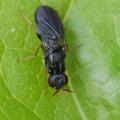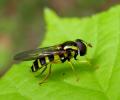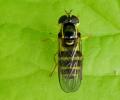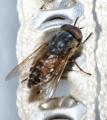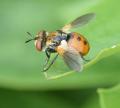Who is here? 1 guest(s)
|
Culex?
|
|
| Sundew |
Posted on 22-11-2007 01:02
|
|
Member Location: Posts: 3890 Joined: 28.07.07 |
Hi, Everyone knows mosquitoes, and in former times I called them all Culex pipiens, but meanwhile I got doubts. The photo shows a typical couple of a species that is very frequent around our house in summer. Is this Culex, or are there similar Aedes species? (Shouldn't Aedes have black and white striped legs?) And can C. pipiens be identified by jizz? Thanks for information! Sundew |
|
|
|
| Tony Irwin |
Posted on 22-11-2007 20:58
|
|
Member Location: Posts: 7168 Joined: 19.11.04 |
Hi Claudia, I think these are both Culex, but I wouldn't like to say which species - they're difficult enough even if you have a specimen! One way to tell whether it's pipiens or molestus is to offer the females a chance to feed on your arm (as long as there's no giant tachinids in the way!  ) - pipiens is primarily a bird feeder, so will show little interest. Cx. molestus will be a more enthusiastic feeder (as long as it's in the mood - this isn't a very good way to tell them apart!) ) - pipiens is primarily a bird feeder, so will show little interest. Cx. molestus will be a more enthusiastic feeder (as long as it's in the mood - this isn't a very good way to tell them apart!)Incidentally, while Aedes (and Culiseta) species often do have stripey legs, some of the species do not. As far as I know all of the Culex species have unmarked legs. Edited by Tony Irwin on 22-11-2007 21:02 Tony ---------- Tony Irwin |
|
|
|
| Sundew |
Posted on 22-11-2007 23:45
|
|
Member Location: Posts: 3890 Joined: 28.07.07 |
Hi Tony, When I see the little girls sitting on the house wall and waiting for me to come home and let them into our sleeping room, I'd say this is Culex molestus (a very suited name!) I know from experience that they do not prefer arms but like every part of me. Thanks for explanations, Sundew |
|
|
|
| Paul Beuk |
Posted on 23-11-2007 08:07
|
|
Super Administrator Location: Posts: 19208 Joined: 11.05.04 |
Actually, molestus and pipiens are the same species but two genetic forms: one that can oviposit without a first bloodmeal, the other that needs to feed on blood first.
Paul - - - - Paul Beuk on https://diptera.info |
|
|
|
| Tony Irwin |
Posted on 23-11-2007 20:59
|
|
Member Location: Posts: 7168 Joined: 19.11.04 |
They are also separated by habitat (at least in Northern Europe) where almost all populations of molestus breed underground or at least enclosed sites in the dark. In these sites they can mate in confined spaces and, as Paul says, the females lay viable eggs without feeding on blood, so vertebrate hosts are not always necessary. Unlike pipiens (normal form) they will breed all year, so can be a real pest in situations like the London underground (metro). I don't think we should hijack Sundew's thread to start a discussion about why two "forms" with such different lifestyles are not regarded as separate, sibling species. Suffice to say that mosquito taxonomists regard them as forms, and I'm not going to argue! 
Tony ---------- Tony Irwin |
|
|
|
| Sundew |
Posted on 23-11-2007 21:27
|
|
Member Location: Posts: 3890 Joined: 28.07.07 |
Well, that's no hijacking - I find this discussion very interesting, as I have to explain the rules of biological nomenclature (as far as I do understand them) to my students. In my field of botany there would be no chance for a species to have two different epitheta; the younger name would have to be dropped and considered a more recent synonym only according to the rule of priority. It could, however, designate a form, so the names, in our mosquito case, should be Culex pipiens forma pipiens and C. pipiens f. molestus (if pipiens is the older name.) Did you mean that, or is zoological nomenclature fuzzier? Sundew |
|
|
|
| Tony Irwin |
Posted on 23-11-2007 22:07
|
|
Member Location: Posts: 7168 Joined: 19.11.04 |
Sundew wrote: so the names, in our mosquito case, should be Culex pipiens forma pipiens and C. pipiens f. molestus (if pipiens is the older name.) Did you mean that, or is zoological nomenclature fuzzier? Sundew That's the currently accepted nomenclature for this little group of mosquitoes. They are genetically different - differences reflected in their different ecology, life history, physiological adaptations and host preferences, but not in their morphology. The discussion that I wanted to avoid was whether clear genetic differences that are not expressed morphologically are sufficient to warrant separate species. Currently the opinion of the mosquito specialists is that they are just forms. I don't know the situation regarding DNA, chromosomes, cross-breeding, etc. All of these help us to decide whether these forms can potentially interbreed, or whether they are completely isolated (and thus more justifiably regarded as separate species). (I have to say that sometimes taxonomists spend far too long arguing about whether forms are varieties, subspecies, species or what. Often there is no clear answer. What is important is to be able to distinguish forms that have different behaviour, physiology or ecology, especially when one regularly bites us and the other one doesn't!) Tony ---------- Tony Irwin |
|
|
|
| Jump to Forum: |


